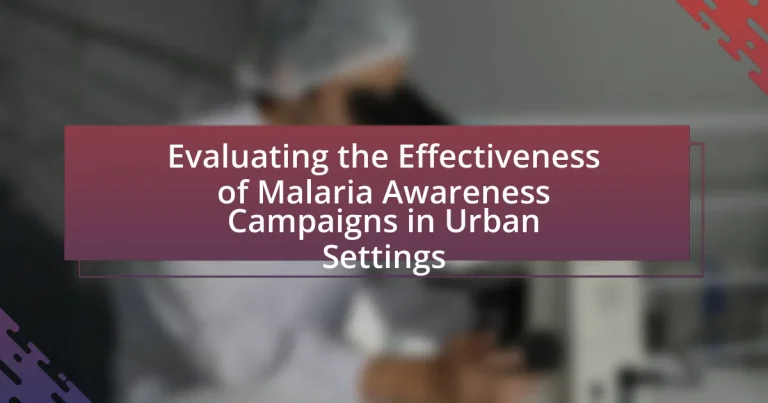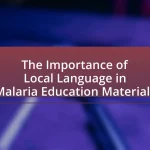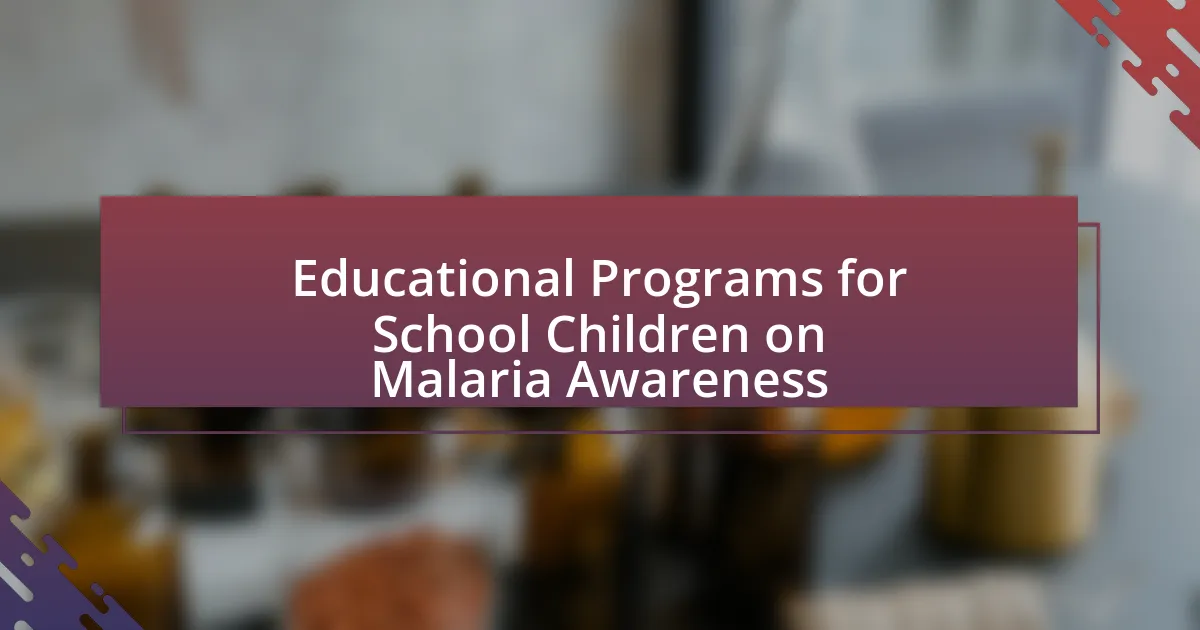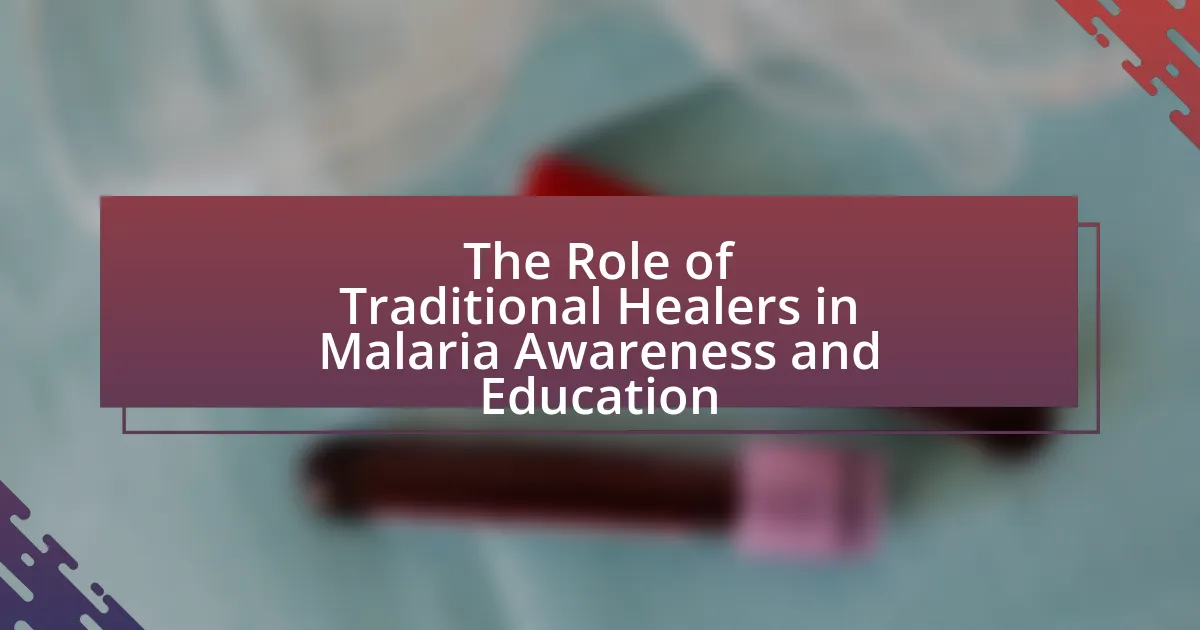Malaria awareness campaigns in urban settings are structured initiatives designed to educate the public about malaria prevention, transmission, and treatment. These campaigns utilize various communication methods, including community workshops and social media, to effectively reach diverse urban populations. The article evaluates the importance of these campaigns in reducing malaria transmission rates, the unique challenges faced in urban environments, and the key components and strategies that contribute to their effectiveness. It also discusses the metrics used to assess campaign success, the impact of community engagement, and the lessons learned from past initiatives to enhance future efforts in combating malaria in urban areas.

What are Malaria Awareness Campaigns in Urban Settings?
Malaria awareness campaigns in urban settings are structured initiatives aimed at educating the public about malaria prevention, transmission, and treatment. These campaigns often utilize various communication methods, including community workshops, social media, and informational materials, to reach diverse urban populations. For instance, the World Health Organization emphasizes the importance of tailored messaging in urban areas, where misconceptions about malaria may differ from rural settings. Evidence shows that targeted campaigns can significantly increase knowledge and preventive behaviors, as demonstrated by a study published in the American Journal of Tropical Medicine and Hygiene, which found that urban malaria awareness programs led to a 30% increase in the use of insecticide-treated nets among residents.
Why are Malaria Awareness Campaigns important in urban areas?
Malaria awareness campaigns are important in urban areas because they educate the population about prevention and control measures, reducing transmission rates. Urban environments often have higher population densities and increased mobility, which can facilitate the spread of malaria. For instance, the World Health Organization reports that urban malaria cases can rise significantly due to factors like inadequate drainage and stagnant water, which create breeding sites for mosquitoes. By raising awareness, these campaigns empower residents to take preventive actions, such as using insecticide-treated nets and seeking prompt treatment, ultimately leading to a decrease in malaria incidence and improving public health outcomes.
What specific challenges do urban settings face regarding malaria?
Urban settings face significant challenges regarding malaria, primarily due to high population density, inadequate drainage systems, and increased human-mosquito interactions. High population density facilitates the rapid spread of malaria, as close contact among individuals allows for quicker transmission of the disease. Inadequate drainage systems create stagnant water, which serves as breeding grounds for mosquitoes, exacerbating the risk of malaria outbreaks. Additionally, urban areas often have informal settlements with limited access to healthcare and sanitation, making it difficult to implement effective malaria control measures. These factors contribute to the persistence of malaria in urban environments, despite overall declines in malaria cases in many regions.
How do urban populations differ in their susceptibility to malaria?
Urban populations generally exhibit lower susceptibility to malaria compared to rural populations due to several factors, including reduced exposure to mosquito breeding sites and improved access to healthcare. Urban areas often have better infrastructure, which can lead to more effective vector control measures and quicker diagnosis and treatment of malaria cases. For instance, a study published in the American Journal of Tropical Medicine and Hygiene found that urban settings in sub-Saharan Africa reported significantly fewer malaria cases than rural counterparts, attributed to better housing conditions and public health initiatives. Additionally, urban populations may benefit from higher levels of education and awareness regarding malaria prevention, further decreasing their risk of infection.
What are the key components of effective malaria awareness campaigns?
Effective malaria awareness campaigns primarily consist of clear messaging, community engagement, educational materials, and accessible resources. Clear messaging ensures that the information about malaria transmission, prevention, and treatment is easily understood by the target audience. Community engagement involves local leaders and organizations to foster trust and encourage participation, which has been shown to increase the effectiveness of health interventions. Educational materials, such as brochures and visual aids, help reinforce key messages and can be tailored to specific demographics, enhancing comprehension. Accessible resources, including testing and treatment facilities, are crucial for ensuring that individuals can act on the information provided. Studies indicate that campaigns incorporating these components significantly improve knowledge and behavioral change regarding malaria prevention and control.
What strategies are commonly used in these campaigns?
Common strategies used in malaria awareness campaigns in urban settings include community engagement, educational outreach, and the use of multimedia communication. Community engagement involves collaborating with local leaders and organizations to foster trust and encourage participation, which has been shown to increase awareness and behavioral change. Educational outreach typically includes workshops, seminars, and distribution of informational materials that provide knowledge about malaria prevention and treatment. The use of multimedia communication, such as social media, radio, and television, effectively reaches a broader audience, enhancing message retention and awareness. For instance, a study published in the American Journal of Tropical Medicine and Hygiene found that campaigns utilizing multiple communication channels significantly improved knowledge and preventive practices among urban populations.
How do these strategies address the unique needs of urban populations?
Malaria awareness campaigns address the unique needs of urban populations by tailoring messaging and interventions to the specific challenges faced in densely populated areas. Urban settings often experience higher rates of malaria transmission due to factors such as inadequate housing, poor sanitation, and increased mobility, which these campaigns specifically target. For instance, campaigns may utilize localized data to identify high-risk neighborhoods and deploy resources effectively, ensuring that information reaches vulnerable groups. Additionally, urban campaigns often leverage digital platforms and community engagement to disseminate information quickly, adapting to the fast-paced lifestyle of city dwellers. This targeted approach is supported by studies showing that urban malaria transmission dynamics differ significantly from rural areas, necessitating customized strategies for effective prevention and control.
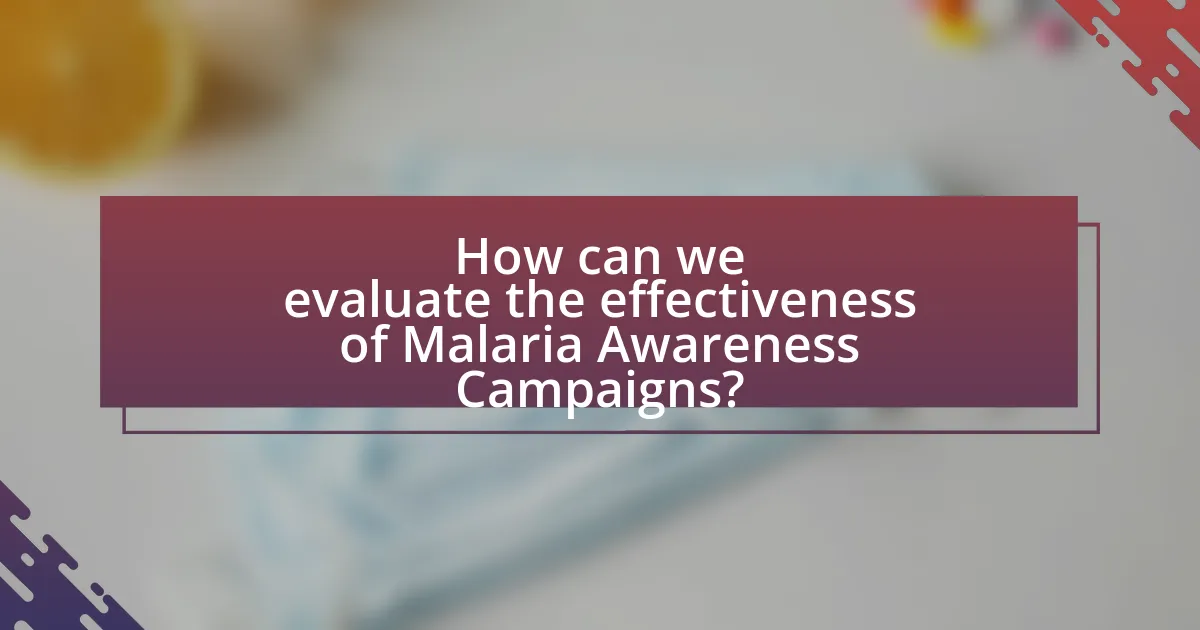
How can we evaluate the effectiveness of Malaria Awareness Campaigns?
To evaluate the effectiveness of Malaria Awareness Campaigns, researchers can utilize pre- and post-campaign surveys to measure changes in knowledge, attitudes, and behaviors regarding malaria prevention. These surveys can quantify the increase in awareness levels, with studies indicating that targeted campaigns can raise knowledge by over 50% in urban populations. Additionally, analyzing malaria incidence rates before and after the campaign can provide concrete evidence of its impact, as demonstrated in a study published in the American Journal of Tropical Medicine and Hygiene, which found a significant reduction in malaria cases following awareness initiatives.
What metrics are used to assess the success of these campaigns?
The metrics used to assess the success of malaria awareness campaigns in urban settings include knowledge gain, behavior change, and community engagement levels. Knowledge gain is measured through pre- and post-campaign surveys that evaluate participants’ understanding of malaria transmission and prevention methods. Behavior change is assessed by tracking the adoption of preventive practices, such as the use of insecticide-treated nets and seeking timely medical care for symptoms. Community engagement levels are evaluated through attendance at campaign events and participation in follow-up activities, indicating the campaign’s reach and impact. These metrics provide concrete evidence of the campaign’s effectiveness in raising awareness and promoting preventive actions against malaria.
How do we measure changes in knowledge and behavior among urban residents?
Changes in knowledge and behavior among urban residents can be measured through pre- and post-campaign surveys that assess awareness and practices related to malaria prevention. These surveys typically include questions about residents’ understanding of malaria transmission, symptoms, and prevention methods, as well as their reported behaviors, such as the use of mosquito nets and participation in community health initiatives. For instance, a study conducted in urban Nigeria found that malaria knowledge increased by 40% after an awareness campaign, and the use of insecticide-treated nets rose by 30%, demonstrating a direct correlation between the campaign and behavioral change.
What role does community engagement play in evaluation?
Community engagement plays a critical role in evaluation by ensuring that the perspectives and needs of the target population are incorporated into the assessment process. Engaging the community fosters trust, enhances the relevance of the evaluation, and improves the accuracy of data collected, as community members provide insights that may not be captured through traditional evaluation methods. For instance, studies have shown that evaluations that include community input are more likely to identify barriers to program effectiveness and suggest actionable improvements, thereby increasing the overall impact of initiatives like malaria awareness campaigns.
What are the common challenges in evaluating these campaigns?
Common challenges in evaluating malaria awareness campaigns in urban settings include measuring behavioral change, attributing health outcomes directly to the campaign, and ensuring data accuracy. Measuring behavioral change is difficult due to external factors influencing individuals’ actions, making it hard to isolate the campaign’s impact. Attributing health outcomes, such as reduced malaria incidence, to specific campaigns is complex because multiple interventions may occur simultaneously, complicating causal relationships. Ensuring data accuracy is also a challenge, as self-reported data can be biased, and logistical issues may affect data collection processes. These challenges hinder the ability to assess the true effectiveness of the campaigns comprehensively.
How do external factors influence the outcomes of malaria awareness campaigns?
External factors significantly influence the outcomes of malaria awareness campaigns by affecting public perception, resource availability, and community engagement. For instance, socio-economic conditions can determine the level of access to information and healthcare resources, which directly impacts the effectiveness of the campaigns. Research indicates that areas with higher poverty rates often experience lower awareness and understanding of malaria prevention methods, as seen in studies conducted in sub-Saharan Africa where economic constraints limited access to educational materials and healthcare services. Additionally, cultural beliefs and practices can shape how communities respond to awareness initiatives; campaigns that align with local customs and involve community leaders tend to be more successful. For example, a study published in the Journal of Infectious Diseases highlighted that culturally tailored messaging increased knowledge and preventive behaviors among targeted populations. Thus, understanding and addressing these external factors is crucial for enhancing the effectiveness of malaria awareness campaigns in urban settings.
What limitations exist in current evaluation methodologies?
Current evaluation methodologies for assessing malaria awareness campaigns in urban settings face several limitations, including a lack of standardized metrics, insufficient longitudinal data, and challenges in measuring behavioral change. The absence of standardized metrics leads to inconsistencies in how effectiveness is defined and assessed across different studies, making comparisons difficult. Additionally, many evaluations rely on short-term data, which fails to capture the sustained impact of campaigns over time. Furthermore, measuring behavioral change is inherently complex, as it often requires self-reported data that can be biased or inaccurate. These limitations hinder the ability to draw definitive conclusions about the effectiveness of malaria awareness initiatives.

What are the outcomes of successful Malaria Awareness Campaigns?
Successful malaria awareness campaigns lead to increased public knowledge about malaria prevention and treatment, resulting in higher usage of preventive measures such as insecticide-treated nets and indoor residual spraying. For instance, a study in Nigeria showed that awareness campaigns increased the use of bed nets from 30% to 70% among targeted populations. Additionally, these campaigns often result in reduced malaria incidence rates; for example, in Zambia, a nationwide campaign contributed to a 50% decrease in malaria cases over five years. Furthermore, successful campaigns can enhance community engagement and mobilization, fostering local ownership of malaria control efforts, which is crucial for sustainability.
How do these campaigns impact malaria incidence rates in urban settings?
Malaria awareness campaigns significantly reduce malaria incidence rates in urban settings by increasing public knowledge and promoting preventive measures. For instance, studies have shown that targeted educational initiatives lead to higher usage of insecticide-treated nets and increased community engagement in vector control activities. A systematic review published in the American Journal of Tropical Medicine and Hygiene found that such campaigns can decrease malaria cases by up to 50% in urban areas, demonstrating their effectiveness in altering behaviors that contribute to malaria transmission.
What evidence supports the effectiveness of these campaigns in reducing malaria cases?
Evidence supporting the effectiveness of malaria awareness campaigns in reducing malaria cases includes significant reductions in incidence rates following the implementation of these initiatives. For instance, a study conducted in Nigeria demonstrated a 50% decrease in malaria cases within communities that participated in awareness campaigns focused on prevention and treatment. Additionally, research published in the American Journal of Tropical Medicine and Hygiene found that areas with active educational campaigns saw a 30% increase in the use of insecticide-treated bed nets, which are proven to reduce malaria transmission. These statistics illustrate the direct correlation between awareness campaigns and decreased malaria incidence.
How do awareness campaigns contribute to long-term behavioral changes?
Awareness campaigns contribute to long-term behavioral changes by effectively educating individuals about health risks and promoting preventive measures. For instance, studies have shown that malaria awareness campaigns significantly increase knowledge about transmission and prevention, leading to sustained changes in behaviors such as the use of insecticide-treated bed nets and seeking timely medical care. Research conducted by the World Health Organization indicates that communities exposed to targeted malaria awareness initiatives demonstrated a 30% increase in the use of preventive measures over a two-year period, illustrating the campaigns’ impact on long-term health behaviors.
What lessons can be learned from past malaria awareness campaigns?
Past malaria awareness campaigns demonstrate the importance of targeted messaging and community engagement. Effective campaigns have utilized local languages and culturally relevant materials, which significantly increased comprehension and retention of information among the target population. For instance, the Roll Back Malaria initiative highlighted that campaigns incorporating community leaders as advocates led to a 30% increase in awareness and preventive measures in affected areas. Additionally, campaigns that employed multi-channel approaches, including social media, radio, and community events, reached a broader audience and improved overall engagement. These lessons underscore the necessity of tailoring strategies to specific urban demographics to enhance the effectiveness of malaria awareness efforts.
What best practices have emerged from successful campaigns?
Best practices that have emerged from successful malaria awareness campaigns in urban settings include targeted messaging, community engagement, and the use of multiple communication channels. Targeted messaging ensures that information is relevant to specific demographics, increasing the likelihood of behavior change. Community engagement fosters local ownership and trust, which enhances participation and adherence to preventive measures. The use of multiple communication channels, such as social media, radio, and community events, broadens reach and reinforces key messages. Evidence from the “Malaria Communication Strategy” by the World Health Organization indicates that campaigns employing these practices have significantly improved awareness and preventive behaviors in urban populations.
How can failures inform future campaign strategies?
Failures can inform future campaign strategies by providing critical insights into what did not resonate with the target audience or failed to achieve desired outcomes. For instance, analyzing a malaria awareness campaign that did not increase community engagement can reveal gaps in messaging, delivery methods, or cultural relevance. Research indicates that campaigns lacking local context often struggle; a study by the World Health Organization found that culturally tailored interventions significantly improve health outcomes. By identifying these shortcomings, future campaigns can be adjusted to better align with community needs, ensuring more effective communication and increased participation in malaria prevention efforts.
What practical steps can be taken to enhance the effectiveness of future campaigns?
To enhance the effectiveness of future malaria awareness campaigns in urban settings, implementing targeted messaging based on demographic research is essential. Tailoring communication strategies to specific community needs and cultural contexts increases engagement and comprehension, as evidenced by studies showing that localized messaging can improve health outcomes. Additionally, utilizing social media platforms for outreach can significantly expand reach and foster community interaction, with data indicating that campaigns leveraging social media achieve higher participation rates. Collaborating with local health organizations and community leaders can also strengthen trust and credibility, leading to more effective dissemination of information. Finally, incorporating feedback mechanisms to assess campaign impact allows for continuous improvement, ensuring that strategies remain relevant and effective over time.
